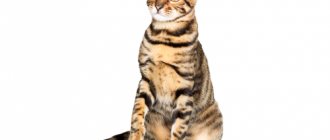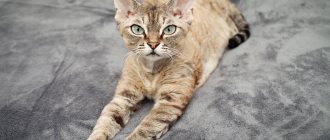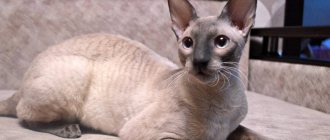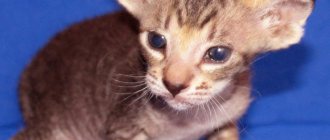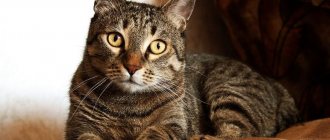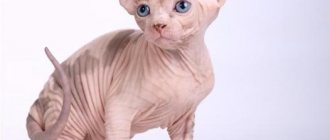The Cornish Rex cat is an amazing short-haired breed. When you look at her, you want to exclaim - this is an alien from outer space! Similar thoughts occur to many people. But not everyone likes the cat's elongated body and short rabbit fur. True lovers of short-haired breeds are touched by the “cosmic” appearance of the Cornish, only they can appreciate both the external characteristics of the cat and its character. Having brought the beauty into the house, they literally forget about everything, giving care and caressing the animal as if this is not a Cornish Rex cat, but a real queen, but is this so?
Origin story
Cat breed Cornish Rex
The history of the Cornish Rex begins in 1950. On one of the farms in the UK, one unusual kitten was discovered in the next litter of a local cat. He had curly fur and huge ears that made the baby look like an alien. All the newborns were distributed, but the unique kitten was kept and named Kalinbuker.
After a while, the farmer decided to castrate him, but the veterinarian dissuaded him. He saw in this animal the prospect of a new breed. Later, several more kittens similar to him were born from Kalinburker. True, only one survived, who was named Poldhu. The farmer's experiments continued for more than one year, and each time half of the litter consisted of lop-eared curly hair.
When the farm suffered a financial crisis, all the curly-haired cats were euthanized. Only Poldhu, who was ransomed, escaped a terrible fate. True, he was later castrated by an absurd accident. But before this moment he managed to leave offspring. The breed received official status in 1983.
Video “Unusual cats from England”
In this video you can immediately see and learn all the differences and features of the two English breeds.
Was this article helpful?
Thank you for your opinion!
The article was useful. Please share the information with your friends.
Yes
No
X
Please write what is wrong and leave recommendations on the article
Cancel reply
Rate the benefit of the article: Rate the author ( 2 votes, average: 3.50 out of 5)
Discuss the article:
Brief description of the breed
Graceful, graceful, with a curly coat - this is a brief description of the Cornish Rex cats. They are small in size, with average height and weight. So, cats gain no more than 3 kg by year, males - 4-4.2 kg. Up to two years they can gain about 200-300 grams, but then growth stops.
Baby Cornish
The pedigree of Cornish Rex is determined according to the standard approved by the world phenological federation TICA.
Head
It has a wedge shape and does not look large relative to the body. Muzzle with prominent cheekbones. The nose is straight, long and of equal width throughout, stopped by a slightly visible line on the convex bridge of the nose. The whiskers on the whiskers and above the eyes are slightly curly. The jaws are strongly developed, the bite is straight. In profile, cats have anterior dentition.
Eyes
They are large, oval in shape with slightly raised extreme corners. They are spaced at a considerable distance, which gives the muzzle more expressiveness. The pupils are constantly dilated. The iris is yellow, green or blue.
Ears
The ears are decent in size and stand out on the small muzzle. Wide at the base, they gradually taper towards the tips, forming rounded shapes.
Limbs
Elongated, slender and toned. The forelimbs are slightly shorter than the hind limbs, so it seems that the cat walks on tiptoes.
Body
Fidget cats
Cats are thin in build, with a long and muscular body. A powerful chest in combination with heavy hips visually creates a feeling of disproportion. The curve of the back is the same as below. The shoulders are impressively developed. The elongated, thin neck adds elegance to the image.
The short coat fits tightly to the body, forming a silky waviness. It is evenly distributed from the muzzle to the tip of the tail.
Bohemian cat appearance
No matter how much a person admires this bohemian, sophisticated beauty, each time it surprises how a unique cat could be born just like that from an ordinary domestic cat! The elongated body and legs suggest comparison with a hound dog, and the huge ears resemble the wings of a butterfly. To some it resembles a bat, and to others it resembles an ordinary rabbit.
If we take the breed standard, the Cornish Rex can be described as a cat with the following parameters:
- elongated muscular body and long limbs;
- paw pads oval;
- the tail is unusually long;
- the size of an adult cat suggests a weight reaching 3-4 kg;
- elongated muzzle with a clearly visible bridge of the nose;
- the fur is curly, the mustache too;
- medium sized head;
- Any color is possible;
- medium-sized eyes - oval;
- the ears are large and widely spaced, wider at the base and rounded at the tip;
- the waves on the coat are directed towards the body very tightly, this is due to the fact that they do not have guard hairs;
- flexible spine, which helps the cat in active games;
- The character is contact, active and sociable.
When buying a 3-5 month old kitten, you need to pay attention to the defects that disqualify the show breed. If there are bald patches on the body, it may seem that it is beautiful, but in reality it is a big drawback! The same applies to wool bristling in places; this should not happen.
Character and habits
These are active enthusiasts who love to have fun and move around. You rarely see them in a calm state; they always find something to do. Any object in the house can become the object of close attention: a basin or bucket, an open closet, curtains, etc. Due to their curiosity, they will not miss a single corner, even a secluded one.
Some habits of Rex are similar to those of a dog. They are loyal to their owner and his family, smart and easy to train. According to reviews from owners, such pets are extremely sociable. They prefer to be around pleasant people when they receive a lot of attention. Even in his absence, they will make themselves known by all sorts of actions: they will sit on their knees, rub against their legs.
Cornish Rexes are good with children. For them, they become a friend and companion in games. They get along with other pets, even large dogs, without any problems. The main thing is that they are of the same good-natured disposition.
Pros and cons of the breed
The advantages of the breed are the following:
- high level of intelligence;
- the ability to find a common language with all family members;
- lack of aggression;
- devotion;
- sociability;
- increased sensitivity to the owner’s mood.
The breed also has disadvantages:
- high price;
- voracity;
- poor tolerance of loneliness;
- need for constant attention.
Colors of Cornish Rex
Regarding coat color, the standard allows for different options, both single-color and multi-color. Thanks to such colorful diversity, Rexes look quite impressive. Cats of the monochrome type are especially valued.
The standard provides for many coat colors for the Cornish Rex.
The most popular colors:
- snow-white;
- blue (gray);
- cream;
- ginger;
- black;
- Siamese;
- tortoiseshell.
About Rex fur
For this royal breed, a continuous wavy coat is desirable, with no bare spots on the skin. In young animals, such places become overgrown with hair over time, but if this does not happen, then in adult cats this is considered a serious drawback. In some, the lower part of the body is covered only with light fluff - this is also a disadvantage of the breed, as is a disheveled or not very wavy coat.
For further selection, it is undesirable to select cats with large or long heads, small ears, and squat bodies. It is also important that the Cornish's tail is not too fluffy, but not bare either.
The unusually long-legged cat breed is a short-haired cat. A distinctive feature of Rex cats is their smooth, silky fur, curled in funny curls, reminiscent of the fur of a broadtail. Thanks to the wavy structure of the coat, rexes differ from their counterparts - this is the main characteristic of the breed. The curls are arranged in the form of relief waves, tightly fitting to the body, and cover the entire body with curly waves. According to standards, a Cornish Rex animal should not have matted hair or bald patches.
Permissible minimum wool:
- near the sebaceous glands;
- the top of the ponytail.
The paws and head may be covered with “velor” fur. The peculiarity of the coat is the same length of the guard and outer coat, which is very thin, crimped and equal to the length of the undercoat.
Care and maintenance
Caring for a Cornish Rex is no more difficult than caring for other members of the cat family. Before the appearance of a curly new settler, appropriate conditions are created. Be sure to purchase the necessary accessories: a toilet tray, bowls for food and water, a comfortable bed, a scratching post.
Rexes are constantly chilly, so a place to rest should be placed away from the front door. It would be ideal to place the cat near heating appliances. Since the arrival of an overly playful pet is expected, it is advisable to equip it like a sports corner: multi-level posts, ladders, ropes, houses. You will definitely need toys.
These are heat-loving cats
Care includes the following procedures:
- Brush the coat at least 2 times a week with a soft brush. Try not to damage the delicate hair structure.
- Nails are trimmed monthly. To do this, use a special tool - a nail clipper.
- Regularly examine the ears and eyes for discharge and inflammation. Wipe with a damp cloth or cotton pad. To moisten the eyes, use a special solution sold in a pet store.
- The pet is not bathed often, as it gets dirty. The water should be warm. After water procedures, the animal is wiped with a terry towel and allowed to dry naturally.
Diet
The menu for the Cornish is compiled individually, depending on age and physiological characteristics. Up to 4 months they feed up to 3 times a day, then switch to a twice-daily regimen. Both industrial feed and natural food are suitable. In the first case, preference is given to premium formulations (in the form of canned food, dry granules).
When planning the diet of your curly cat, it is worth taking into account the fact that Rexes are prone to overeating. Therefore, you must strictly adhere to the feeding schedule - morning and evening. Any snacks are excluded.
Recommended foods for a natural diet:
- frozen lean meat (chicken, rabbit, turkey);
- boiled offal;
- cereal porridge;
- boiled vegetables (carrots, pumpkin, eggplants);
- quail and chicken eggs (boiled);
- sprouted cereals;
- fermented milk products;
- greenery.
It is forbidden to give bony fish, cow's milk, legumes and sweets.
Most of the daily diet should consist of meat and offal. It is advisable to first roll them into minced meat or finely chop them. Don't forget to pour fresh water every day.
Walk
Cornish Rexes quickly become hypothermic and can become ill. Therefore, they walk with them mainly in the warm season. In cold weather, keep your pet warm with special clothing. Cats like to frolic outside, which is more typical for dogs.
Nutrition
The Cornish's main diet is wet canned food; dry food makes up only a sixth of their diet. If the pet is naturally fed, then the diet should be planned so that 2/3 of it consists of meat and offal. An ideal source of protein is beef or minced beef. You can also offer your pet rabbit, turkey or boiled chicken.
It is highly not recommended to give cats fish, because it provokes the development of urolithiasis. Sour cream and cream are allowed only for adults, but for children it is better to give children's cottage cheese without additives.
Due to their high physical activity, they have a voracious appetite and are ready to eat whatever is offered. However, in old age it can lead to obesity. In order for the pet to stay in shape, the owner must control its diet.
Diseases and health problems
Under good conditions, cats of this breed can celebrate their twentieth anniversary. Despite their random origin, they can boast of excellent health. No diseases are inherited along the genetic line. If they get sick, they recover quickly without consequences. This is due to the innate strong immunity in animals.
Diseases to which Rexes are susceptible:
- Hypothyroidism. It develops due to a lack of thyroid hormones in the body, which leads to damage to the dermis, fur and loss of appetite.
- Hypokalemia. Appears against the background of calcium deficiency. In rare cases, it is inherited from parents.
- Hypotrichosis. Increased hair loss - baldness. At the same time, the cat’s well-being does not deteriorate.
- Alopecia. Partial baldness (on the stomach, paws, sides). The cause is hormonal imbalance and lack of vitamins.
Sometimes Cornish Rexes develop retinal atrophy.
If the room is drafty, there is a high risk of your pet catching a cold. Cystitis may develop as a complication. It is important to maintain a favorable temperature.
Feeding
Photo: https://www.flickr.com/photos/farmking/1222160995/
Cornish Rex cats have an excellent appetite, but at the same time often have digestive problems. That is why nutrition must be of high quality and balanced. Owners often choose premium or super-premium dry food. Their advantage is that they have everything you need and do not require any additional costs for vitamins.
There are also no contraindications for natural feeding. You just need to comply with a number of requirements. The main component of natural food is meat and offal. You need to supplement your diet with cereals, fermented milk products, vegetables, and eggs. But it is not advisable to give fish to cats.
Your pet's diet should include greens. As practice has shown, cats eat sprouted oats very well, replenishing the lack of vitamins and microelements in the body.
When feeding your pet naturally, be sure to give it vitamins. The veterinarian will tell you which to give preference during certain periods of your pet’s life.
With any type of feeding, the animal must be able to quench its thirst with clean water at any time.
Cornish Rex cats tend to be overweight, but you are unlikely to see a fat cat of this breed. Constant movement helps you burn extra calories and stay in great shape.
Proper nutrition is an integral part of proper care and will help prolong the life of your pet.
Breeding
There are up to five newborns in one litter.
Representatives of this breed reach sexual maturity at the age of about 8-9 months. Just don't rush into knitting. We must give the young body time to gain strength and the hormonal levels to stabilize. Breeders recommend postponing this process until the cat's second heat.
A partner is selected in advance. This is due to the rarity of the breed. According to the standard rules, Cornish cannot be mixed with representatives of other breeds, so as not to lose the dominant gene - responsible for curly hair, large ears and a typical physique.
When choosing a female cat for the upcoming mating, adhere to the standard rules:
- impeccable pedigree;
- excellent health;
- experience in this matter.
If the “groom” has already lost his “virginity,” the likelihood of pregnancy on the first try increases significantly.
Before such a significant event, both pets must undergo antiparasitic treatment. Claws are trimmed so that the couple does not injure each other in a fit of passion. It is advisable to refuse vaccinations. It is better for the pimping to take place in the cat’s home. They bring the cat there and leave it for several days (maximum 5-6).
Gestation lasts from 63 to 65 weeks. Usually childbirth proceeds easily, without outside help. The onset of labor is marked by changes in the behavior of the woman in labor - anxiety appears, a desire to hide somewhere. Babies are born weighing no more than 100 grams. There are up to 5-6 of them in a litter. Their fur is curly, but soon straightens out. It begins to curl again after the first molt.
Health, tendency to disease
Corinche Rex cats are distinguished by good health; a possible reason for good immunity is a slightly elevated temperature (38.5-39 ° C). No genetic problems (breed diseases) were found. The most common types found in rexes are:
- skin diseases (dermatitis);
- colds of the respiratory tract;
- gastrointestinal disorders;
- cystitis (inflammation of the bladder).
Animals tend to overeat, which can cause obesity. Cornish Rexes are very sensitive to anesthesia drugs, therefore, unlike cats of other breeds, they take longer to recover from anesthesia. An overdose of sedatives used before surgery can cause complications: deafness, neurological disorders, damage to brain cells, and death.
It is recommended to have a first aid kit for your cat. Need to buy:
- cotton wool,
- cotton buds,
- elastic bandage,
- gauze,
- patch,
- brilliant green,
- iodine,
- hydrogen peroxide,
- Activated carbon,
- Vaseline oil (Vaseline),
- scissors with blunt tips,
- tweezers,
- eye dropper,
- rectal thermometer,
- syringes, incl. insulin,
- ammonia,
- boric acid powder,
- streptocide powder.
Vaccination
They begin when the kitten is 8 weeks old. First you need to rid the animal of fleas and ticks, then deworm it. The remedy for parasites is given 10-12 days in advance. before vaccination. First, they are vaccinated against panleukopenia, calicivirus and rhinotracheitis. Revaccination is necessary after 2-4 weeks, then 1 time per year.
Starting from the age of 12 weeks, they are given a rabies vaccination (once), revaccination – annually.
After 2-3 weeks. The kitten is vaccinated against fungal diseases. 2 injections are required, with an interval of 10-14 days, revaccination - every year.
Quarantine after vaccinations should last 10 days, during which it is important to protect the baby from:
- overheating;
- hypothermia;
- strong physical activity;
- long transportation;
- contacts with other pets;
- suspected sources of infection (for example, street shoes).
Castration and sterilization
If you do not plan to breed Cornish Rex, then it is better to do castration (sterilization). The procedure is carried out when the pet turns 9 months old - the period of puberty. It is not recommended to do this before, which can lead to defective formation of the reproductive system.
Smooth fur in kittens is not a defect
The animal is operated on in a veterinary clinic under general anesthesia. Everything takes about 20 minutes, then the cat is given to the owner. The next day, the anesthesia is completely leveled, but the pet will need careful care for several more days. If after 24 hours the pet has not recovered from anesthesia, you must visit the veterinary clinic again.
It is worth noting that Rexes do not tolerate anesthetics well. Therefore, anesthesia does not always go well.
Recommendations for choosing a kitten
It is not recommended to buy pets at the “bird market” or in pet stores, as there is a high risk that they will sell you a sick or fake Cornish Rex. It is better to take an animal from nurseries, breeders or friends.
It is worth paying attention to how the kittens live there, find out information about the parents and, if possible, look at them, analyzing their behavior.
It is necessary to take a kitten no earlier than 2.5 months from the moment of birth, so that by the day it is transferred to a new family, it has grown up and received the necessary lessons from its mother. Good breeders' kittens by this time already know how to go to the toilet, are accustomed to food and vaccinated against diseases. But the price from such sellers is often very high.
Determining the purebredness of Cornish kittens causes great difficulties, since the main characteristic of this breed - curls on the fur - is usually absent in kittens at the time of purchase. They are born with wavy fur, which becomes straight by the end of the first week after birth. Kittens acquire their curly hair only at 6–8 months. This is why it is so important to buy a kitten only from trusted nurseries with a good reputation.
Cornish Rex kittens lose their curls about a week after birth.
Cornish Rex and Devon Rex kittens are very similar to each other. Devons are also born curly and lose this feature by about two months of age. In order not to confuse Cornish Rex kittens with babies of other breeds, you need to focus on other signs that have already been described above: head shape, ear size, etc.
Cornish and Devon Rex have very different head shapes
When purchasing a kitten, the breeder must provide the new owner with original documents on the baby’s pedigree (certificate of origin and permission to obtain a pedigree), a veterinary passport indicating the date and names of all vaccinations given.
The cost of cornish depends on their purpose:
- Breeding class kittens, which are used for further breeding, can be purchased for 31 thousand rubles;
- pet-class animals, which can only be pets and are subject to sterilization, can be purchased for 25 thousand rubles;
- Show-class kittens that can participate in exhibitions cost about 50 thousand rubles.
Kittens of this breed can be purchased in the following nurseries:
- DEJ-LAXI (Moscow);
- Kornelita (Moscow);
- Island of legends Sa (St. Petersburg);
- Jimdo (Kyiv);
- MonAmour Elf (Kyiv);
- Arbor vitae (Minsk).
When choosing the sex of an animal, you should decide on your preferences. Cats are cleaner and less active than males. They tend to cost more than males. But cats are very active and, no matter how strange it may be, more affectionate than females. They are also more curious.
Immediately at the time of purchase, you need to examine your future pet for diseases or defects. To make sure that the animal is healthy, you must:
- make sure there is no discharge from the nose or eyes;
- inspect the ears - they should be clean;
- pay attention to the fur: it should not be pale;
- make sure there are no insects (fleas, ticks) in the animal’s hair;
- examine the skin for peeling, scratches, bumps and tumors;
- feel the stomach: it should not be very large and soft;
- pet the baby: when stroking the belly, the animal should not show dissatisfaction;
- Look under the kitten's tail: there should be no redness, cracks or discharge on the anus.
Cost and how to buy
Cornish Rex is a rare breed of cat, so it is risky to buy a kitten from random advertisements and without documents. You need to contact specialized nurseries or trusted breeders. Negligence may cost replacement, since many unscrupulous sellers pass off other similar breeds as Cornishes.
They first visit the place where the kitten is kept, look at the conditions and the pet itself. It would not be superfluous to find out his pedigree, assess the condition of the parents (general health, behavior, presence of disqualifying defects).
How much small Cornish Rexes cost depends on the class:
- show - within 30-60 thousand rubles;
- brid – from 15 to 20 thousand rubles;
- pet - no more than 10 thousand rubles.
You can always find out any information about the animal from the breeder.
Vaccinations and antiparasitic treatment
To prevent the curly-haired cat from becoming a victim of standard infections, she is vaccinated against panleukopenia, calcivirosis, rabies and rhinotracheitis. The first vaccination for a Cornish Rex kitten is given at 7-8 weeks with a mandatory repeat after 28 days. Subsequently, a cat of this breed is vaccinated once a year.
To prevent diseases transmitted by fleas and worms, the Cornish Rex is regularly sanitized. Anthelmintic drugs are given to the cat twice a year, repeated every 10-14 days. To get rid of fleas, the Cornish Rex's fur is treated with special drops or shampoos.
Differences between the Cornish Rex and the Devon and Selkirk Rex
There are several breeds of curly-haired cats, united by one prefix in the name - Rex: Cornish, Devon, German and Selikirk. Based on their external features, the first two representatives are often confused. But for comparative analysis, you can also include Selkirk Rex.
Selkirk rex
Devon Rex
It will be difficult for an ignorant person to visually distinguish the Cornish Rex from the Devon Rex. The main emphasis is on wool, or more precisely, its type. Devon curls are not ordered, but create a careless tousle. The reason for this is the structure of the hair, the tip of which is directed upward. A similar situation is observed in the Selkirk Rex. In addition, the latter have longer fur, so the cats look shaggy.
True, the beauty of the Devons is changeable. After three years, their fur periodically changes: it straightens, curls, thins, and thickens. There are certain reasons for this.
Cornish Rex
The Cornish Rex's fur falls in smooth waves evenly over the entire body, like the hairstyle of Hollywood stars in the past. The ends of the hairs point down, which gives the curls order. With age, the waves acquire greater elasticity, but do not lose their softness and silkiness.
How else do the appearances of these three representatives differ:
| Variety | Head | Nose | Ears | Body type |
| Cornish Rex | Cone-shaped, elongated, with prominent cheekbones | Long, smooth | Large, set high, rounded at the top | Lean, long, outwardly similar to ballerinas. |
| Devon rex | Heart shaped | With a clear transition in the bridge of the nose | Voluminous, low-set, with sharp tips | Compact, muscular, well-built. They have a developed skeleton. |
| Selkirk rex | Round, wide with plump cheeks | Extended, short | Small, triangular in shape | Squat, massive, big-boned. |
But everyone has a friendly, easy-going disposition and excessive playfulness in common. Cats are extremely active, cheerful, without the slightest aggression towards people. They are born smart and inquisitive. Everyone quickly becomes attached to the owner.
Ural Rex: Russian curly cat
In our country, cats with curly hair appeared at about the same time as in America. In the city of Zarechny, Sverdlovsk region, the cat Mura gave birth to three kittens, two of which had atypical curly hair. The owners kept one funny baby for themselves, calling it a traditional cat name - Vasily.
After some time, felinologists from Yekaterinburg heard about the handsome man with curly fur, and they convinced the owners to show the cat at an exhibition held by CFF. Vasya was a success, and it was decided to start a new breed by mating him with his mother.
Urals with original genes
By the way, there is an opinion that curly-haired cats appeared in the Urals before - old-timers talked about such unusual animals. And there is confirmation of this. Vasily was not the only curly-haired cat born in this region. In Sverdlovsk in the same years, the cat Musya took part in the exhibition with two curly-haired kittens - they were acquired by Leningrad breeders.
Felinologists were able to prove that the gene responsible for the structure of the coat in Ural cats is not the same as in foreign rex cats. In 1994, the Ural Rex breed standard was adopted. The coat of these cats can be either short or semi-long.
In the first case, dense, silky and soft fur covers the cat’s body in a wave with an elastic curl. In the second, the waviness is less pronounced, but a small mane and curls on the tail are noticeable.
Ural rexes are loved by their owners for their easy-going nature, balanced character and developed intelligence. They subtly sense the owner’s mood and understand what they want from them.
This breed still remains very rare - nurseries can be counted on one hand. The breeding of Ural rexes is carried out mainly by enthusiasts who are very scrupulous in choosing owners for their “graduates”.
Interesting Facts
Despite the fact that the Cornish Rex breed appeared not so long ago, a lot can already be said about it. Here are some fun facts:
- Loyalty to the owner is akin to that of a dog. The cat is ready to follow him anywhere. Constantly rests on knees or shoulder. Sometimes he even tries to climb on his head.
- They are unique in terms of intelligence, so they are easy to train. If desired, it is not difficult to teach a pet various tricks: to bring thrown objects, to respond to dog commands.
- Since these cats do not have guard hairs, the coat does not retain heat. Therefore, it is better to buy an insulated house-bed for your pet’s rest.
- This breed is suitable for allergy sufferers - their fur does not cause a painful reaction in them. True, they shed no less than other cats, so you will have to clean the house often.
- Prolonged exposure of the Cornish Rex to the sun can cause burns on the skin. Therefore, it is recommended to walk them in the morning or evening, when solar activity is minimal.
- Corniches are very gluttonous. It is better to underfeed them once again. With systematic overeating, they quickly get fat, become lazy and clumsy. Experts advise giving them a fasting day once a month.
- To get healthy kittens from your well-born cat, you should not allow frequent births. Once every couple of years is enough. But you can’t extend the pause either. Then disturbances in the reproductive system may develop.
Description and photo
Cornish Rex cats definitely stand out in appearance compared to representatives of other cat breeds - an elongated, egg-shaped head, the length of which is 2 times longer than width, huge eyes and high mobile ears, unusually long legs and short fur. These cats are very sporty and athletic, their love for running, jumping, playing and cat antics is endless and continues throughout their lives. A distinctive feature of cats is their fur: soft, very thick, resembling astrakhan fur to the touch, and all because it lacks guard hairs.
Did you know? The soft, short, wavy coat of the Cornish Rex is the result of a spontaneous, natural mutation that often occurs in the cat world.
Breed standard
The Cornish Rex cat breed has the following appearance standards:
- Weight range : Females and males weigh about 3 and 4.5 kg, respectively.
- Eye color: varied - amber, copper, gold, blue, green, yellow, orange.
- Life expectancy: 9-13 years.
- Shedding: poorly expressed.
- Coat length: short.
- Coat color: plain or multi-colored (two- and three-color).
- Cat size: small to medium.
- Country of origin: England.
Types of colors
The variety of colors of the breed is amazing: Cornish Rex individuals can be of all shades and colors; there are even Siamese colors, which are called Sirex. White spots can be combined with all colors except Siamese.
The following coat colors are considered common:
- Solid colors (white, black, silver or blue, cream, red). No admixtures of other shades are allowed; the eyes are often golden.
- Smoky shades, including silver, black, blue. In all cases, individuals have a white undercoat.
- Tabby shades - cats have contrasting spots evenly distributed throughout the body. Color options include: classic tabby, brindle, silver, spotted, cream, red.
- Tortoiseshell color, which is characterized by red (fawn) spots on a black background. There is also a smoky version of this color, in which the undercoat has a white tint.
- The calico color is characterized by the presence of gray and red spots on the white coat. The spots are predominantly found on the back and sides of the body, and the belly of the paws is white.
The Cornish Rex's fur is surprisingly soft to the touch, flowing over the body in soft folds from the top of the head to the tail, short, but thick and warm. Many people have the impression that the animal’s body temperature is higher than that of other cats, but this is not the case. It’s just that the fur is so short, soft and close to the body that it makes it possible to feel the true temperature of the pet.
Character of cats
Animals of this breed have a lively mind, natural curiosity, are very energetic and playful. They will try to participate in all the affairs of their owner, often need attention and are not shy about asking for it. When you bring your pet home, don’t expect the kitten to sleep peacefully on your lap—this is clearly not the case with the Cornish Rex breed. An agile, active and intelligent animal will turn any activity into a game, will do everything to attract attention and almost cause applause from the owner. These are very smart cats; to keep their minds occupied with interesting things, you can teach them tricks, buy puzzle toys, and by solving them the animal can be rewarded with a treat or stroking.
Check out such popular cat foods as Royal Canin, Kitekat, Hills and Purina.
This activity of the animal is explained by its physique: these are strong, athletic cats, with long legs and developed muscles, capable of high jumps, sharp turns, starts and stops. Although in appearance they look thin, thin-boned and even graceful. Undoubtedly, like all members of the family, they are not averse to taking a nap on a soft pillow, but they certainly cannot be called couch potatoes or decorative animals. Animals quickly learn all the habits and daily routine of their owner, learn very quickly, and love to play and climb. Cats are not averse to climbing to the highest point in the house to inspect their territories.
Bengal and British cats are considered the most beautiful.
If they get their hands on an interesting thing, they will certainly start a lively game, so make sure that all valuables are securely hidden, and also hide the items so that the animal does not see your actions. The Cornish Rex's personality makes it an ideal pet for families with children, frequent guests, or other pets. These are extremely sociable cats that will take advantage of any opportunity to sit on their owner's lap or kiss them. A trip to the veterinarian with such a pet will not be a problem. Also, cats of this breed have a certain therapeutic effect, thanks to the pleasure they experience from stroking and sitting in a person’s arms. It is noteworthy that Cornish Rex individuals retain their sociable, playful disposition until old age.

